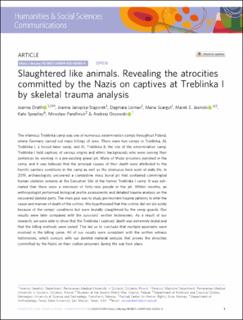| dc.contributor.author | Drath, Joanna | |
| dc.contributor.author | Jarzęcka-Stąporek, Joanna | |
| dc.contributor.author | Lisman, Dagmara | |
| dc.contributor.author | Szargut, Maria | |
| dc.contributor.author | Jasinski, Marek E. | |
| dc.contributor.author | Spradley, Kate | |
| dc.contributor.author | Parafiniuk, Mirosław | |
| dc.contributor.author | Ossowski, Andrzej | |
| dc.date.accessioned | 2023-11-07T13:51:53Z | |
| dc.date.available | 2023-11-07T13:51:53Z | |
| dc.date.created | 2023-09-04T09:53:40Z | |
| dc.date.issued | 2023 | |
| dc.identifier.citation | Humanities & Social Sciences Communications. 2023, 10 (1), . | en_US |
| dc.identifier.issn | 2662-9992 | |
| dc.identifier.uri | https://hdl.handle.net/11250/3101158 | |
| dc.description.abstract | The infamous Treblinka camp was one of numerous extermination camps throughout Poland, where Germans carried out mass killings of Jews. There were two camps in Treblinka, AL Treblinka I, a forced labor camp, and KL Treblinka II, the site of the extermination camp. Treblinka I held captives of various origins and ethnic backgrounds who were serving their sentences by working in a pre-existing gravel pit. Many of those prisoners perished in the camp, and it was believed that the principal causes of their death were attributed to the horrific sanitary conditions in the camp as well as the strenuous hard work of daily life. In 2019, archaeologists uncovered a clandestine mass burial pit that contained commingled human skeleton remains at the Execution Site of the former Treblinka I camp. It was estimated that there were a minimum of forty-nine people in the pit. Within months, an anthropologist performed biological profile assessments and detailed trauma analysis on the recovered skeletal parts. The main goal was to study perimortem trauma patterns to infer the cause and manner of death of the victims. We hypothesized that the victims did not die solely because of the camps’ conditions but were brutally slaughtered by the camp guards. Our results were later compared with the survivors’ written testimonies. As a result of our research, we were able to show that the Treblinka I captives’ death was extremely brutal and that the killing methods were varied. This led us to conclude that multiple assailants were involved in the killing spree. All of our results were consistent with the written witness testimonies, which concurs with our skeletal material analysis that proves the atrocities committed by the Nazis on their civilian prisoners during the war took place. | en_US |
| dc.language.iso | eng | en_US |
| dc.publisher | Nature | en_US |
| dc.rights | Navngivelse 4.0 Internasjonal | * |
| dc.rights.uri | http://creativecommons.org/licenses/by/4.0/deed.no | * |
| dc.title | Slaughtered like animals. Revealing the atrocities committed by the Nazis on captives at Treblinka I by skeletal trauma analysis | en_US |
| dc.title.alternative | Slaughtered like animals. Revealing the atrocities committed by the Nazis on captives at Treblinka I by skeletal trauma analysis | en_US |
| dc.type | Peer reviewed | en_US |
| dc.type | Journal article | en_US |
| dc.description.version | publishedVersion | en_US |
| dc.source.pagenumber | 0 | en_US |
| dc.source.volume | 10 | en_US |
| dc.source.journal | Humanities & Social Sciences Communications | en_US |
| dc.source.issue | 1 | en_US |
| dc.identifier.doi | 10.1057/s41599-023-02002-4 | |
| dc.identifier.cristin | 2171961 | |
| cristin.ispublished | true | |
| cristin.fulltext | original | |
| cristin.qualitycode | 1 | |

